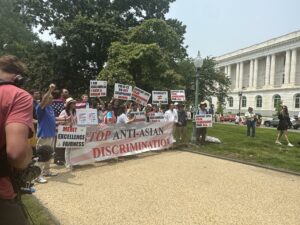Law & Liberty: Is It Time to Stop Asking About Race?

We’ve all checked the boxes on race and ethnicity questionnaires, a staple of most government applications and surveys, and they have never made much sense. On ethnicity, they ask whether you are “Hispanic or Latino” or “Not-Hispanic or Latino,” which is about as sensible a question as asking a mammal if it’s a cat or not a cat. And the racial groups don’t match up to reality either. “Asian” describes you whether you hail from the sweltering tip of the Indian subcontinent or the frozen port of Harbin, China, 3,900 miles to the northeast.
The federal Office of Management and Budget is now proposing to inject some rationality into these questions. But rather than mend racial data collection, the government should just stop. Data collection on race tells us little of genuine value and foments discrimination.
The government has collected race data for a long time. The 1790 census divided us into three groups: free white people, slaves, and “all other free persons.” About a half-century later, the government offered three “color” options to free people: white, black, and mulatto. The government tossed in an “Indian” category in 1860, “Chinese” in 1870, “Japanese” in 1890, and “Mexican” and “Hindu” in 1930. In an odd blip, the 1890 census tried out multi-racial categories: “quadroon” (1/4 Black) and “octoroon” (1/8 Black). We’ve shied away from multi-racial status since then.
Nowadays, the government relies on categories hammered out in 1977, which have aged about as well as denim suits and shag carpet. There’s the light-switch ethnicity question of “Hispanic” or “not-Hispanic,” then a list of four racial categories: “American Indian or Alaskan Native,” “Asian or Pacific Islander,” Black, and White. Middle Easterners west of the Pakistani border have long been considered “White,” a political echo left over from the Soviet Union. In the eyes of your government, the freckled redheads of Scotland share the same racial category as sunbaked Bedouin nomads. And if you’re a person of mixed race, you take your pick. Naturally, people tend to pick the one that most benefits them or seems trendy. As Justice Gorsuch noted in the Supreme Court’s recent affirmative action decision, these categories are “irrational stereotypes” with no grounding in reality.
The government itself recognized problems with these categories even then, warning that the “classifications should not be interpreted as being scientific or anthropological in nature, nor should they be viewed as determinants of eligibility for participation in any Federal program.” This caveat has been widely ignored, with the knowing complicity of federal government civil rights enforcement agencies. Universities have long relied on these categories to insert racial preferences in admissions and hiring. Likewise, programs that help small businesses have relied on these categories to decide which business owners receive a suite of benefits. A small business 51 percent owned by a Pakistani will automatically qualify for special government benefits, but one owned 100 percent by an Afghan from the wrong side of the Pakistani border does not.
The government’s proposed fix to these problems is to make the categories more granular. For instance, they want to create a “Middle East and North African” (MENA) category. They would also add a category for descendants of American slavery and create sub-groups within broader racial categories, such as Japanese under the Asian umbrella and Italian under White.
The time has come to reconsider this whole enterprise. It’s certainly past time that the federal government does something about its outdated system of racial data collection. But how about laying aside the project altogether?
Racial data collection has not served good causes. France ceased publishing racial data after the Vichy regime used racial records in rounding up and deporting Jews to death camps. Nazis regularly relied on racial and ethnic data collected in other occupied countries’ census records, tax returns, and official records to hunt down and deport Jews to camps. In fact, the Dutch resistance bombed the Amsterdam civil registry office in 1943 to destroy records that Nazis used to locate Jews. Canada likewise ceased tabulating race in 1951 in response to Nazi atrocities.
The United States government has likewise used racial data to discriminate. After the bombing of Pearl Harbor, the military imposed strict curfews and removal orders in West Coast regions for all people of Japanese ancestry. The military knew which areas to target, thanks to census data showing that Japanese populations were highly concentrated in Seattle, Portland, and Los Angeles.
Abuse of such data is not a thing of the past, and governments often use racial data to balance or award race-based preferences in various programs. Last year, a federal court found that the Fairfax County school board had relied on racial data in an unconstitutional scheme to discriminate against Asian-American students in admissions to the top-ranked Thomas Jefferson High School. In 2020–21, the racial makeup of Thomas Jefferson’s student body was 72 percent Asian American, much higher than the 20 percent throughout the area’s public schools regionally.
This imbalance displeased school board members, who seem to subscribe to Thanos’s creed regarding race proportions: “perfectly balanced, as all things should be.” Thanks to race-based data collection, the school board altered the school’s admissions requirements to discriminate against Asian-American applicants. The school board knew that Asian-American students were highly concentrated in specific middle schools. This data informed the board’s method for reducing Asian-American enrollment at Thomas Jefferson by guaranteeing seats to top-performing students from each middle school. Before that time, admission was based on top performance across the region.
In the first year under the new system, the admitted class size increased by 64 students, yet Thomas Jefferson admitted 56 fewer Asian-American students than the previous year. This was not a fluke. In the five years prior, Asian-American students made up at least 65 percent of each admitted class, and the class of 2024 was 73 percent Asian American. Following the admission changes, that percentage dropped to 54 percent. My employer, Pacific Legal Foundation, is representing a coalition of parents in challenging this discriminatory scheme, and it prevailed in the trial court when the federal district court ruled that the school board intentionally discriminated in violation of federal law. A divided court of appeals recently reversed the trial court, and the Supreme Court will soon decide whether to review the case. Many anticipate that universities will engage in similar proxy discrimination now that the Supreme Court has cracked down on explicit racial preferences in college admissions.
The Fairfax County School Board is not alone. States regularly rely on data showing various racial disparities as evidence to justify racially discriminatory practices. For instance, statistical disparity studies, which purport to show that certain minority groups are underrepresented or underperforming in a particular industry, are often used to justify disadvantaged business enterprise programs that favor government contractors owned by minority business owners. While this approach contradicts the courts’ demand for concrete evidence of intentional discrimination in the given industry, disparity studies continue to prop up these openly discriminatory programs.
Aggregated data on race also contribute to dubious applications of a concept called “disparate impact.” Anti-discrimination laws and enforcement practices have come to focus less on intentional discrimination and more on statistical disparities. For instance, under federal fair housing laws, actions or policies that have an unintended impact on a minority group can give rise to liability. In the early 2000s, St. Paul, Minnesota, cracked down on landlords who ignored rat problems, inadequate sanitation, poor heating, etc., but instead of shaping up, the landlords sued the city for violating the federal Fair Housing Act. They argued that St. Paul’s insistence upon habitable homes hurt minorities by forcing the landlords to raise the rent. The landlords (and the rats) won. This disparate impact notion has leaked into other areas, such as employment discrimination, where neutral employment criteria and testing can violate the law if they disproportionately affect minorities. Many innocent and worthwhile endeavors have a disparate impact, whether killing rats or administering merits testing.
Racial data collection might be important if statistical disparities inevitably result from racism. But they do not. Disparities across racial and ethnic groups stem from a complex roil of factors. Vietnamese Americans are heavily overrepresented in the nail salon business. Is systemic racism within the manicure industry crushing non-Vietnamese? Of course not. The disparity is largely a byproduct of actress Tippi Hedren’s volunteer work in Vietnamese refugee camps decades ago, where her manicurist taught a group of Vietnamese girls how to do nails, and those girls opened businesses and trained others in their community.
And what about Indian Americans, the highest-income racial group in the United States? Or the eighteen racial and ethnic groups who out-earn whites, like Lebanese Arabs, Filipinos, and Nigerians? White supremacy is an unlikely culprit to explain these disparities. Aggregate data on race tell us very little, if anything at all, about racism in America.
So does this evidence show that racial data collection is worthwhile as a tool for debunking myths about racism? For example, economist Thomas Sowell used census data on race as early as 1980 to show black college-educated couples earned more than their white counterparts. Unfortunately, the race narrative seems immune to such evidence. Race peddlers are like Vizzini from The Princess Bride, who shouts “Inconceivable!” whenever his companions point out that the Man in Black is still closing in. The race evidence does not mean what they think it means, so they end up drinking the poisonous draught of tribal politics, a smug smile still on their lips.
Would the new proposal to provide more granular racial and ethnic categories improve matters? Almost certainly not. More detailed racial data cannot cure the endeavor’s fundamental flaws and may only lend a veneer of legitimacy to discriminatory practices. For example, the federal proposal proposes to break down “Asian” into subgroups such as “Japanese,” “Hmong,” and “Cambodian” to better understand “within-group disparities.” Of course, a broad category such as “Asian” contains vastly different racial, ethnic, and national identities, but more granular data collection will make it easier for governments to discriminate against specific races and ethnicities. For example, Harvard and the University of North Carolina were recently before the Supreme Court on allegations of discrimination against Asian Americans because they are seen as over-represented. If such institutions had access to more granular data regarding which Asian-American subgroups are doing better than universities might wish, then they could simply discriminate with a higher degree of precision.
Nor do these more granular categories remove the fundamental arbitrariness rooted in any system of racial classifications. A category such as “Japanese,” for instance, still sweeps in a diverse amalgam of groups, such as multi-generational native-born Americans as well as first-generation immigrants, as well as different groups within Japan itself, such as the Ainu people indigenous to Hokkaido or the Ryukyuan people indigenous to the Ryukyu Islands chain. The federal government could further divide them by religious persuasion, political background, educational background, economic status, sexual orientation, etc. Assuming any degree of homogeneity among even more granular subgroups is insulting.
Indeed, the federal proposal to chop up the population into disaggregated racial groups lays bare the illegitimacy of the entire project. Peeling away layer after layer of ever-more specific distinctions among peoples will be doomed until the final layer of artificial categories is stripped away to reveal the bedrock unit of society: the individual. And for any government action to be legitimate and just, it is at that fundamental level that government decisions must be made.
Perhaps broad data collection once told us something useful. But that is less and less true as cultures and peoples intermingle more and our fates become less tethered to our birthplace. Nowadays, most self-identified African Americans have European or Native American heritage. And many self-identified whites have African or Native American ancestors. I have an ancestor born into slavery and Cherokee blood from settlers who integrated into Cherokee communities and trekked with them westward along the Trail of Tears. I’m also Jewish, a group that has long resisted placing their ethnic background on official documents for good reason. What does a monolithic racial category say about me? Likewise, consider my three cousins, white kids born after my great uncle had moved to China during the Communist Revolution and raised speaking only Mandarin Chinese. They still speak with a Chinese accent to this day. When my cousins check “White” on a federal reporting form, the designation obscures more than it reveals. The uselessness of such categories will only grow with time.
Meanwhile, there is a real cost to the government dividing us into arbitrary racial and ethnic groups. It enables discrimination and validates tribalism at odds with the individualism at the root of the American success story. Jason D. Hill, a Jamaican American philosophy professor at DePaul, has written that “Americans are the first individualist and, by design, the first nontribal people in the world.” Racial data collection imposes clumsy groupings that stoke tribal tendencies and aid and abet discrimination. In our increasingly multicultural and multi-racial society, these categories say little about us. It’s time that the federal government set aside the racial sorting hat.
This op-ed was originally published at Law & Liberty on July 13, 2023.

















